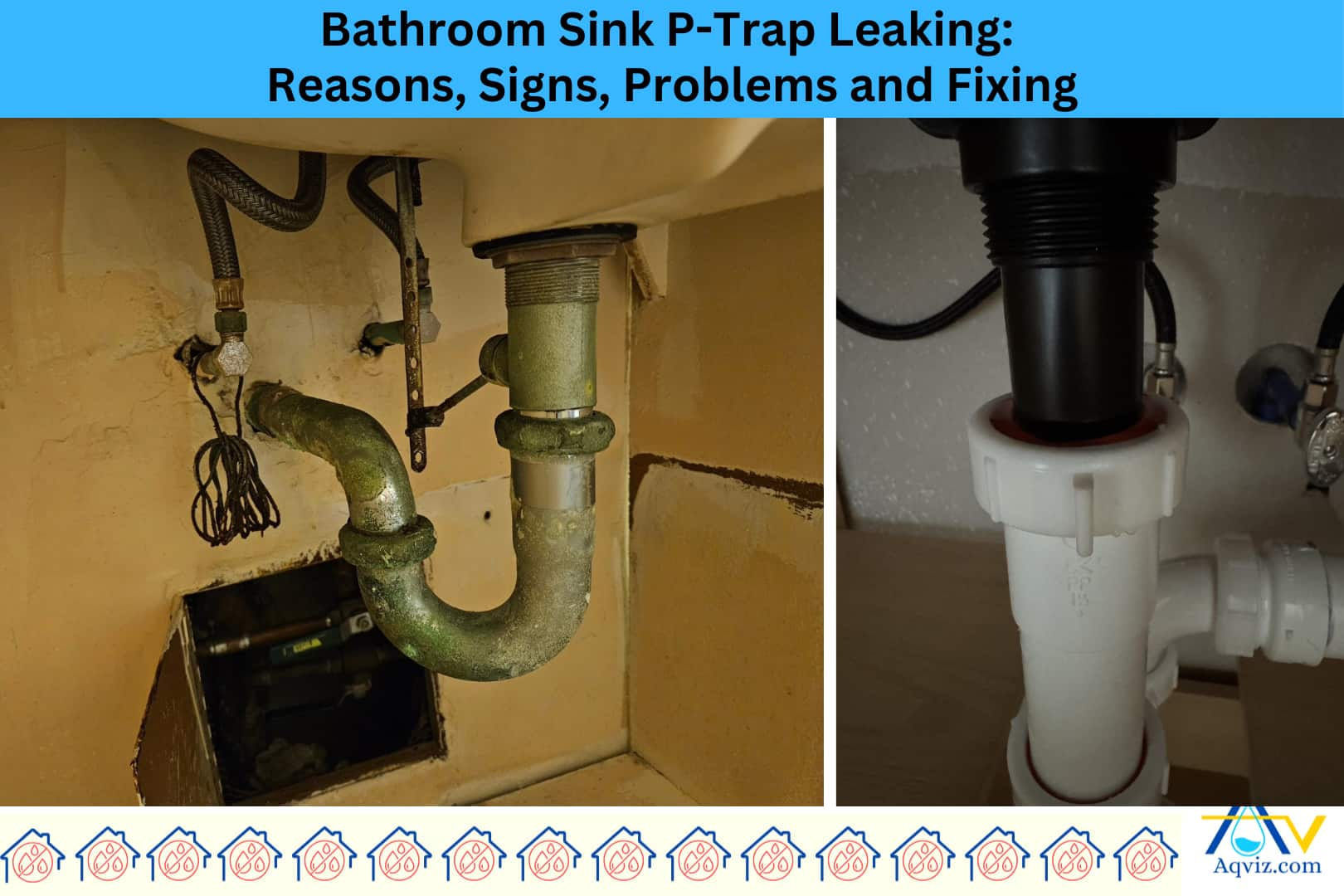Bathroom Sink P-Trap Leaking: Reasons, Signs, Problems and How to Fix

Bathroom sink P-trap leaking occurs when water escapes from the curved section of the drainpipe located beneath the sink. P-Trap leaks at the slip joint washers, threaded nuts, or cracks along the pipe curve, leading to slow drips or constant moisture under the sink. The bathroom sink P-trap is leaking due to loose slip nuts, worn compression washers, cross-threaded fittings, cracked trap components, and poor alignment with the drainpipe.
You can detect P-trap leaking in the bathroom sink, including water dripping during or after use, water damage inside the cabinet, musty or sewage odor, visible corrosion or discoloration, and loose-fitting and hand-tightened connections. Prolonged P-trap leaking causes bad odor release, mold growth, cabinet damage, sewer gas exposure, and water puddling and slip hazards in the bathroom.
To minimize the P-trap leaking impact, you should waterproof the vanity base and regularly inspect plumbing connections. To fix these serious water problems, Aqviz experts have prepared a step-by-step guide to repair/fix them successfully. Check the step-by-step guide and let us know if there is any problem with this. Aqviz experts are always available 24/7.

What is a Bathroom Sink P-Trap Leaking?
Bathroom sink P-trap leaking occurs when water escapes from the curved section of the drainpipe located beneath the sink. P-Trap leaks at the slip joint washers, threaded nuts, or cracks along the pipe curve, leading to slow drips or constant moisture under the sink. The P-trap, usually made of PVC, ABS, or chrome-plated brass, holds a small amount of water to block sewer gases from entering the bathroom.
Bathroom sink P-trap leaking is often caused by loose connections, worn compression washers, cross-threaded fittings, or brittle pipe joints. Prolonged P-trap leaking leads to water damage inside vanity cabinets, encourages mold colonies, softens particleboard shelving, and creates musty odors in the bathroom.
Hence, Aqviz experts advise sealing all threaded joints with Teflon tape, replacing deteriorated gaskets, and applying a liquid waterproof membrane on the cabinet floor. Installing a drain pan liner or HDPE moisture barrier beneath the cabinet base also helps contain leaks from a P-trap, preserving the area from rot and mold development.
Read More About: Bathroom Waterproofing: Everything You Should Know
What are the 4 Reasons For a P-trap leaking in the Bathroom?
There are 4 reasons for P-trap leaking in the bathroom: loose slip nuts, worn compression washers, cross-threaded fittings, cracked trap components, and poor alignment with the drainpipe.
- Loose slip nuts : Slip nuts can be loose due to vibration, hand overtightening, or improper installation. Hence loosened slip nut creates small gaps at the P-trap joints where water leaks during drainage.
- Worn compression washers : The shape and flexibility of the compression washer can loosen over time. When these washers no longer form a tight seal, water seeps out of the joints during sink use.
- Cross-threaded fittings : When installing the trap arm or tailpiece, the threads can be misaligned. It causes the trap to prevent sealing fully and results in continuous dripping around the P-trap connection points.
- Poor alignment with the drainpipe : If the tailpiece, trap bend, or trap arm is forced into a misaligned position, it strains the connections. This tension causes leaks at the joints, especially when the sink experiences heavy water flow.
How to Detect a Bathroom Sink P-Trap Leaking?
These are the major signs to detect P-trap leaking in the bathroom sink, including water dripping during or after use, water damage inside the cabinet, musty or sewage odor, visible corrosion or discoloration, and loose-fitting and hand-tightened connections.
- Water dripping during or after use : If you observe drops of water falling from the P-trap connection when the sink is running or shortly after, it is direct proof of a leak caused by loose slip nuts or worn washers.
- Water damage inside the cabinet : When you see warped wood, bubbling laminate, or water rings inside the vanity cabinet, these marks are strong evidence that the P-trap is leaking continuously and saturating the cabinet base.
- Musty or sewage-like odor : If you smell a damp, musty, or sewage-like odor from under the sink, this odor is a strong signal that water is leaking and stagnating inside the cabinet, encouraging mold and bacteria.
- Visible corrosion or discoloration : When you observe rust stains or mineral buildup around the trap fittings is strong evidence of a slow leak that allows water to evaporate and leave mineral traces.
- Loose fittings or hand-tightened connections : If you feel that the slip nuts or compression joints are loose or spinning freely, it is a common mechanical failure and clear proof of a leaking P-trap.
What are the Problems of a P-trap Leaking in the Bathroom?
There are 5 problems due to the P-trap leaking in the bathroom, such as bad odor release, mold formation, cabinet damage, sewer gas exposure, and water puddling. Persistent leaks from the trap affect bathroom hygiene, safety, and plumbing efficiency.
- Bad odor release : P-trap leaking breaks the water seal that blocks sewer gases. This allows foul smells to escape into the bathroom, creating an unhealthy and uncomfortable indoor environment.
- Mold formation in closed spaces : Leaky P-traps create dampness inside vanity cabinets or behind wall panels. This trapped moisture promotes mold growth, which affects air quality and leads to respiratory discomfort.
- Cabinet and material damage : Leaks from P-traps cause water to soak into particleboard vanities, laminate finishes, and surrounding trim. These materials lose strength, swell, and eventually require replacement.
- Sewer gas exposure : Broken or leaking P-traps can release methane and other harmful gases into living areas. This exposure negatively impacts occupant health and violates building code safety standards.
- Water puddling and slip hazards : P-trap leaks under the sink may go unnoticed until water accumulates on the floor. This standing water increases slip risks and can damage flooring materials like tile or vinyl.

How to Minimize the Impact of P-Trap Leaking in the Bathroom Sink?
To minimize the impact of P-trap leaking in the bathroom sink, you should waterproof the vanity base and regularly inspect plumbing connections. Here are 4 effective methods to reduce the damage caused by P-trap leaks.
- Waterproof the vanity cabinet base : Apply a waterproof coating or place an HDPE liner at the bottom of the cabinet to stop water from soaking into the wood or laminate. This prevents swelling, rot, and mold growth caused by hidden leaks.
- Seal all P-trap joints properly : Use thread seal tape, compression washers, and ensure tight slip nut connections to stop water from escaping the P-trap. Proper sealing helps reduce the risk of small drips turning into major leaks.
- Install a drain tray or catch pan : Place a drain pan or leak tray beneath the sink plumbing to catch unexpected drips. This solution helps prevent standing water from damaging cabinetry or flooring.
- Inspect fittings and washers regularly : Periodically check the trap arm, tailpiece, and washers for signs of looseness or wear to stop leaks early. Regular maintenance helps to prevent long-term damage and improve drainage efficiency.
How to Fix a Bathroom Sink P-Trap Leaking?
To fix a bathroom sink P-trap leaking, you should follow the 5-step guide below. At Aqviz, we’ve used this reliable method on countless plumbing repairs for all of our clients.
- Locate and inspect the leak: First things first, you should begin by placing a dry towel or paper tissue around the P-trap, slip nuts, and trap arm. Then you can run the faucet and observe for moisture. This helps identify whether the leak is due to a loose fitting, cracked pipe, or worn washer.
- Disassemble the P-trap assembly : Using channel-lock pliers or an adjustable wrench, you can loosen the slip nuts connecting the trap to the tailpiece and wall pipe. You must keep a bucket under the trap to catch any standing water inside the pipe.
- Clean and inspect all components : You can clean all pipe ends, washers, and threads using a nylon brush and vinegar solution to remove buildup and debris. Then you should inspect the rubber or plastic washers for cracks or deformation.
- Reassemble and reseal the trap : Then you should reconnect the trap, aligning the parts without forcing them. All slip nuts are hand-tightened first, then gently snugged with pliers. You should avoid overtightening, which can crack the plastic. You can also apply plumber’s tape on threads for a tighter seal if needed.
- Test the connection for leaks : Once assembled, you should run water for 2-3 minutes and wipe all joints with a dry cloth. You also wrap tissue paper around the connections to detect slow drips. If no moisture appears, the fix is confirmed, and the drain is safe to use.
Aqviz Experts have investigated all of the bathroom water damages and listed out the 8 most common water damage in the bathroom and prepared a complete guide for each water problem with including reasons, signs, problems, and how to fix it properly as an expert. So we highly recommend you to refer to all of these 8 bathroom problems.
- Bathroom Sink Drain Leak
- Bathroom Faucet Leak
- Hot Water Leak
- Toilet Leak
- Bathtub Overflow
- Cracked Shower Tray
- Bathroom Broken Tiles
- Bathroom Mold
What is a P-Trap?
A P-trap is a curved plumbing pipe installed beneath sinks to prevent sewer gases from entering the bathroom. It holds a small amount of water that acts as a barrier between the drain system and the living space. P-traps are made of PVC, ABS plastic, and chrome-plated brass. Its main task is to trap debris and block foul odors while allowing wastewater to flow smoothly into the drainage system.
Should you Waterproof the Sink Wall?
Yes, you should always waterproof the sink wall, especially around plumbing penetrations and behind vanities. You should apply liquid waterproofing membranes or waterproof backer boards before installing sinks. This helps prevent mold, rot, and tile damage in case of P-trap leaks, backsplash splashes, or faucet overflows.
How often Should you Replace a P-Trap?
You should replace a P-trap every 8 to 10 years, or sooner if you notice corrosion, cracks, persistent leaks, or clogs. At Aqviz, we recommend inspecting P-traps during routine plumbing maintenance. Plastic traps may degrade faster in high-moisture environments, while metal traps corrode over time if not properly sealed.
